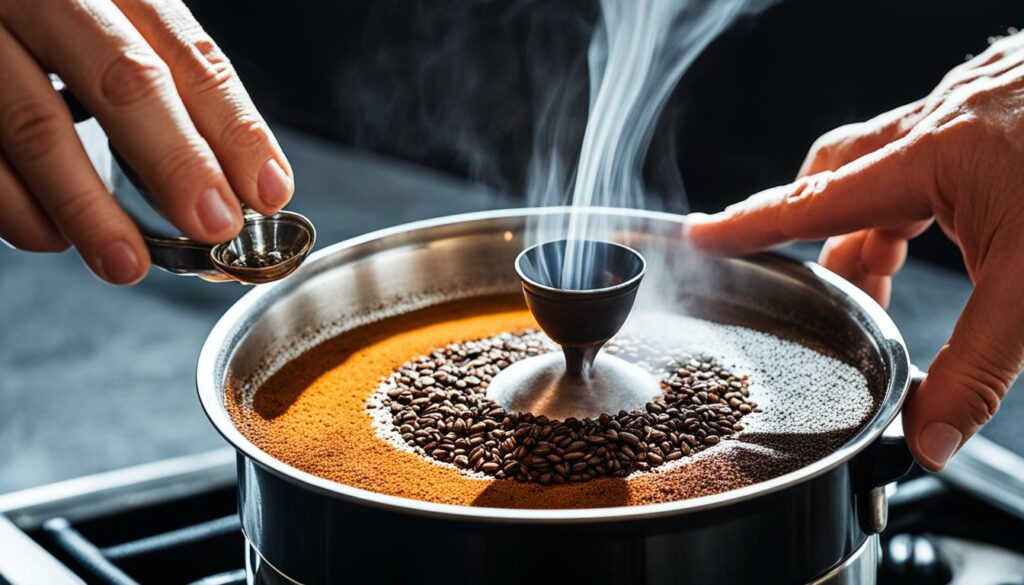Do you want to savor the rich and authentic taste of Turkish coffee right in your own home? Look no further! We’re here to reveal the ultimate guide that will teach you the best way to brew Turkish coffee. Whether you’re a coffee enthusiast or simply curious about the fascinating world of Turkish coffee, we’ve got you covered with tips, tricks, and a step-by-step recipe that will make you a master in no time.
But first, let’s take a moment to appreciate the essence of Turkish coffee. Imagine the aroma of freshly roasted beans filling the room, the deep and robust flavor dancing on your taste buds. Turkish coffee is more than just a drink; it’s a reflection of a rich cultural heritage and centuries-old traditions. And now, you have the opportunity to experience it firsthand.
So, are you ready to discover the secrets behind the perfect cup of traditional Turkish coffee? Let’s embark on this flavorful journey together!
The Allure of Turkish Coffee: A Rich History
Turkish coffee has a fascinating history that dates back to the 1400s. It is renowned for its strong flavor and intense aroma, making it a beloved cultural tradition in Turkey and other countries. In this section, we will explore the rich history and origins of Turkish coffee, its association with the Ottoman Empire, and its ties to Yemeni coffee.
While there are various stories about the origins of Turkish coffee, it is widely believed to have originated in Yemen and traveled to the Ottoman Empire. The coffee’s popularity soared during the reign of the Ottoman Sultans, who were known for their appreciation of coffee. Turkish coffee became an important part of the court culture, and it quickly spread throughout the empire.
Understanding the Essentials: The Turkish Coffee Pot (Cezve/Ibrik)
The Turkish coffee pot, also known as Cezve or Ibrik, is a key element in the process of brewing Turkish coffee. Its unique design and cultural significance contribute to the authentic experience of this beloved beverage. Understanding the importance of the Turkish coffee pot and choosing the right one for your brew is essential to achieve the perfect cup of Turkish coffee.
The Significance of Cezve and Ibrik in Turkish Coffee Preparation
The Turkish coffee pot, whether called Cezve or Ibrik, has a long history and holds a special place in Turkish coffee culture. The pot is traditionally made of copper, a material that conducts heat evenly and helps maintain the optimal brewing temperature. Its long handle and narrow neck make it easy to handle and pour with precision.
One of the unique features of the Turkish coffee pot is its small size, typically designed to brew one or two servings of coffee at a time. This allows for greater control and ensures that each cup is brewed to perfection, allowing for the rich flavor and thick foam that define Turkish coffee.
Material Matters: Choosing the Right Pot for Your Brew
When choosing a Turkish coffee pot, the material it is made of is an important consideration. While traditional copper pots are widely used and favored for their heat conductivity, there are also other options available. Some coffee enthusiasts prefer stainless steel or brass pots, which offer durability and ease of maintenance.
Each material has its own unique properties that can impact the brewing process and the flavor of the coffee. Copper pots, for example, are believed to enhance the taste and create the signature foam of Turkish coffee. Stainless steel pots, on the other hand, offer a more contemporary look and are easier to clean.
Ultimately, choosing the right pot comes down to personal preference and the brewing experience you desire. It’s important to consider factors such as heat conductivity, maintenance, and aesthetics when selecting a Turkish coffee pot that suits your needs.
Now that we understand the significance of the Turkish coffee pot and how it affects the brewing process, let’s move on to the next section, where we will explore the role of Turkish coffee beans in achieving the perfect cup of coffee.
The Fine Grind: Why Turkish Coffee Beans Matter
Turkish coffee beans are a crucial element in achieving the authentic flavor and aroma of Turkish coffee. The grinding process and grind size play a significant role in extracting the full potential of these beans. Choosing the right beans and using the correct grind size are key factors in brewing a perfect cup of Turkish coffee.
Choosing Your Turkish Coffee Beans for Optimal Flavor
When selecting Turkish coffee beans, it is essential to prioritize quality. Opt for freshly roasted beans that are specifically labeled for Turkish coffee. These beans are typically roasted to a darker degree, retaining their rich flavors and oils. Look for reputable brands that specialize in Turkish coffee beans, ensuring that you are getting the highest quality product.
Consider the following factors when choosing Turkish coffee beans:
- Roast: Dark roast beans are preferred for Turkish coffee as they provide a deep and robust flavor.
- Origin: Single-origin beans from regions like Ethiopia, Brazil, or Yemen can offer unique tasting notes.
- Freshness: Choose beans that have been recently roasted to ensure optimal flavor and aroma.
By carefully selecting your Turkish coffee beans, you can enhance the overall taste and experience of your brewed coffee.
Grinding Techniques for Authentic Turkish Coffee
Grinding Turkish coffee beans to the correct consistency is crucial for achieving the distinctive texture and flavor of Turkish coffee. The traditional grind is ultra-fine, almost powder-like, which allows for efficient extraction during the brewing process.
To achieve the authentic Turkish coffee grind, consider the following techniques:
- Invest in a quality Turkish coffee grinder specifically designed for achieving a fine grind.
- Grind the beans just before brewing to preserve the freshness and flavors.
- Adjust the grind size according to your personal preference. Experiment with finer or coarser grinds to find the perfect balance.
- Use a gentle, consistent hand while grinding to ensure an even and uniform texture.
Mastering the art of grinding Turkish coffee beans will result in a cup of coffee that is rich, aromatic, and full-bodied.
Best Way to Brew Turkish Coffee: Mastering the Technique
In this section, we will guide you through the step-by-step process of brewing Turkish coffee using the traditional method. Brewing Turkish coffee is an art that requires precision and attention to detail. By following these instructions carefully, you’ll be able to achieve that rich, full-bodied cup of Turkish coffee that you crave.
Gather Your Ingredients and Equipment
Before you begin, make sure you have all the necessary ingredients and equipment on hand. Here’s what you’ll need:
- Turkish coffee beans
- Water
- Turkish coffee pot (Cezve or Ibrik)
- Coffee grinder
- Sugar (optional)
- A heat source (stovetop or traditional sand heater)
Ensure that your coffee beans are fresh and of high quality for the best flavor.
Measure and Grind the Coffee
For a single serving of Turkish coffee, you’ll need approximately one heaping teaspoon of coffee grounds per cup. Grind the coffee beans into a fine powder. The grind size is crucial for achieving the unique texture of Turkish coffee.
Measure the Water
Measure the water using the Turkish coffee cup, also known as a fincan. For each cup of coffee, you’ll need one fincan of water. This traditional measurement ensures a consistent flavor and strength.
Prepare the Coffee
Pour the measured water into the Turkish coffee pot and add the desired amount of sugar. The sweetness level can be adjusted to your preference or omitted altogether. Place the pot on the heat source.
Brewing Process
Slowly heat the coffee over low heat, stirring continuously with a small spoon or whisk. This stirring motion helps to create a frothy texture. As the coffee heats up, you’ll notice a foam forming on the surface. Allow the coffee to come to a gentle simmer but avoid boiling.
Remove from Heat and Let It Settle
Once the coffee starts simmering, remove it from the heat immediately. Let the coffee settle for a moment, allowing the grounds to sink to the bottom of the pot.
Serve and Enjoy
Slowly pour the brewed coffee into the fincan, being careful not to disturb the settled grounds at the bottom of the pot. Turkish coffee is traditionally served alongside a glass of water to cleanse the palate. Sit back, relax, and savor the rich flavors and aromas of your freshly brewed Turkish coffee.
Now that you have mastered the technique, you can enjoy the unique experience of brewing and sipping authentic Turkish coffee in the comfort of your own home.
Cultural Variations: Exploring Different Names for Turkish Coffee
Turkish coffee, with its long history and cultural significance, goes by various names in different regions, each influenced by historical context and cultural preferences. Let’s delve into the naming conventions of Turkish coffee and discover how different cultures have adopted their own names for this iconic beverage. Additionally, we will explore regional preferences for Turkish coffee and how they contribute to the identity of this beloved drink.
Historical Context and Naming Conventions
The naming of Turkish coffee is deeply rooted in history. Throughout its journey, Turkish coffee has been influenced by different cultures and traditions. In some regions, it is known as Armenian coffee or Greek coffee, reflecting the historical connections and influences of these cultures on Turkish coffee. These different names for Turkish coffee demonstrate the diverse interpretations and local customs associated with this cherished drink.
Regional Preferences and Their Impact on Turkish Coffee Identity
The regional variations of Turkish coffee not only include different names but also unique brewing techniques and serving styles. Each region has its own preferences when it comes to the strength, sweetness, and presentation of Turkish coffee. These regional differences contribute to the overall identity of Turkish coffee, showcasing the cultural richness and influences that have shaped this beverage over time.
By understanding the cultural variations in Turkish coffee naming conventions and regional preferences, we gain a deeper appreciation for this cherished drink and its place in different societies. Through exploring different names and traditions, we can celebrate the diverse cultural influences that have made Turkish coffee a beloved beverage worldwide.
Water and Heat: Achieving the Perfect Coffee Temperature
In the world of Turkish coffee brewing, water temperature and heat management are crucial for achieving the perfect cup. The right water temperature ensures that the coffee grounds extract the desired flavors, while effective heat management prevents over-extraction or scorching of the coffee.
The Critical Role of Water Quality in Turkish Coffee
Water quality plays a significant role in the overall taste and aroma of Turkish coffee. It is essential to use high-quality water that is free from any impurities or strong odors. Opt for filtered water or spring water to ensure a clean and pure brew.
Finding the Sweet Spot: Heat Management During Brewing
Heat management is key to maintaining the ideal brewing temperature for Turkish coffee. The traditional method involves using low heat throughout the brewing process to gently extract the flavors from the coffee grounds. This slow and steady approach allows for better control and ensures the coffee doesn’t boil or burn.
By carefully managing the heat, you can achieve the perfect balance of flavors, creating a rich and velvety cup of Turkish coffee. Experiment with different heat settings on your stovetop to find the optimal temperature for your brewing style.
Crafting the Perfect Cup: A Step-by-Step Guide to Brewing
In this section, we will provide a detailed step-by-step guide for brewing Turkish coffee, incorporating all the essential elements discussed in the previous sections. Whether you are a beginner or an experienced coffee enthusiast, this guide will help you craft the perfect cup of authentic Turkish coffee.
-
Start by gathering all the necessary equipment: a Turkish coffee pot (Cezve/Ibrik), Turkish coffee beans, a grinder, and a heat source.
-
Measure the amount of water you will need based on the number of cups you want to brew. The general rule is one demitasse cup per person.
-
Grind the Turkish coffee beans to a very fine consistency. The grind should be similar to powdered sugar.
-
Add the ground coffee to the Turkish coffee pot. The amount of coffee needed depends on your personal preference and the strength of the brew.
-
Pour the measured water into the Turkish coffee pot, ensuring that it reaches just below the neck of the pot.
-
Place the Turkish coffee pot on a heat source and set the heat to low. Allow the coffee to heat slowly, stirring occasionally.
-
As the coffee heats, you will begin to see a foam forming on the surface. Allow the foam to rise but be careful not to let it boil over.
-
Once the foam has risen, remove the coffee pot from the heat and let it settle for a moment.
-
Repeat the heating and settling process two more times to ensure a rich and flavorful cup of Turkish coffee.
-
Pour the brewed coffee into demitasse cups, ensuring that each cup receives an equal amount of foam.
-
Allow the coffee to settle for a brief moment before taking your first sip and savoring the delicious flavor.
Congratulations! You have successfully brewed a cup of authentic Turkish coffee. Experiment with the coffee-to-water ratio and brewing time to find your preferred taste. Enjoy this rich and aromatic beverage in the comfort of your own home.

Conclusion
In conclusion, brewing Turkish coffee is a delightful process that entails attention to detail and careful execution. By following the steps outlined in this guide, you can achieve a cup of Turkish coffee that is both authentic and delicious.
One of the essential aspects of brewing Turkish coffee is using high-quality ingredients. From selecting the right Turkish coffee beans to grinding them to the perfect consistency, every element contributes to the rich flavor and aroma of the final brew.
Furthermore, investing in proper equipment such as a traditional Turkish coffee pot and managing the heat during the brewing process ensures optimal temperature control and enhances the overall experience. Mastering the brewing technique, including the precise water temperature and brewing time, is also crucial for achieving a perfect cup of Turkish coffee.
In summary, brewing Turkish coffee requires patience, attention to detail, and a deep appreciation for the rich traditions and cultural heritage associated with this iconic beverage. By focusing on the quality of your ingredients, using the right equipment, and mastering the brewing technique, you can savor the unique flavors and aromas of authentic Turkish coffee in the comfort of your own home.













